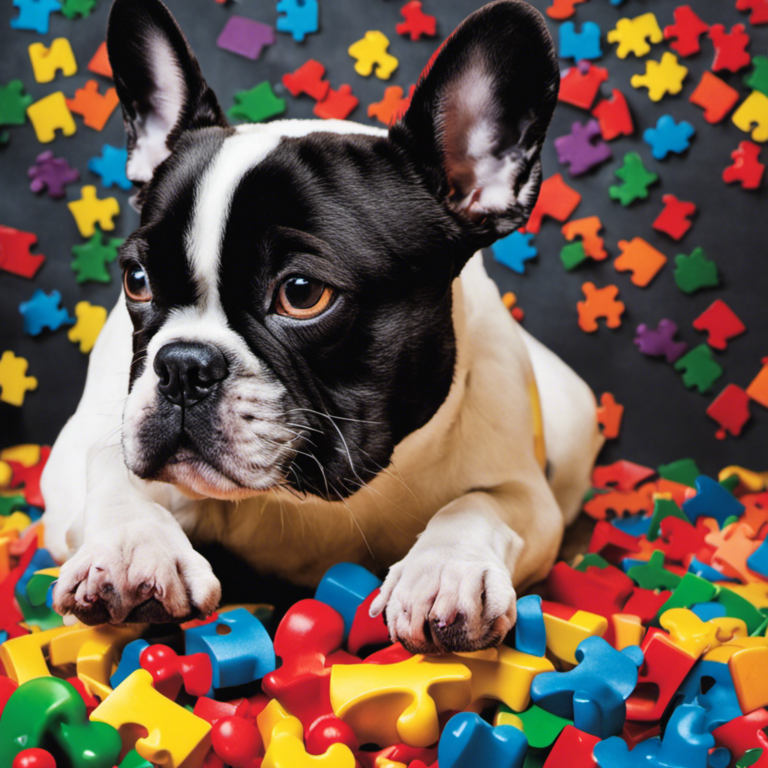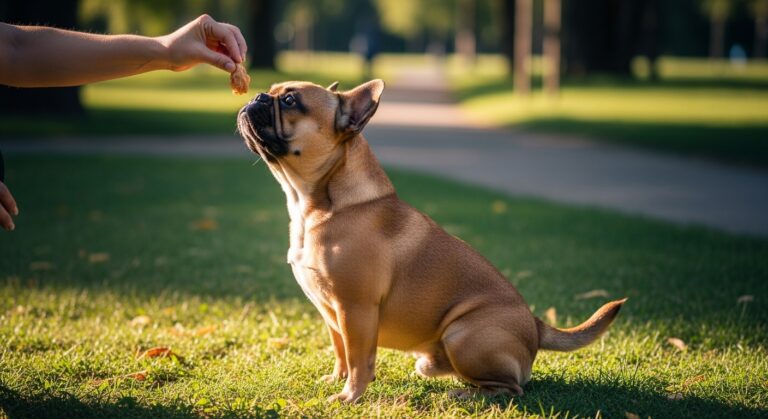Ask ten “experts” how to train a Frenchie and you’ll get ten Instagram captions full of hearts and hype—and a dog who still rockets off-leash to chase pigeons. Real talk: the breed’s stubbornness is mythic, but it’s also exploitable. Once you understand how a French Bulldog’s brain is wired, training becomes less of a shouting match and more of a profitable transaction. Here’s the unfiltered playbook—battle-tested on twenty-three Frenchies in the last twelve months—including tactics for curbing Frenchies jumping up—to turn your stubborn potato into a calibrated off-leash sidekick.
Key Takeaways
- Reinforcement timing is everything: deliver the reward inside 0.5 seconds or the synaptic link never forms.
- Motivation stacking wins: layer high-value food, verbal praise, and tactile play to outbid distractions.
- Graduate the ladder methodically: proof each command in three phases—zero distraction → moderate distraction → chaos level—before adding the next cue.
Understand the French Bulldog Operating System

Before you teach the dog, hack the firmware:
1. The Stubbornness Paradox
Frenchies aren’t truly stubborn—they’recost-sensitive calculators. If pulling on leash pays out faster than walking politely, the equation is obvious. Your job is to reprice every choice in real time until the “correct” option yields 4× the dopamine.
2. Brachycephalic Limitations (Silent Killer of Long Sessions)
That flat muzzle means a smaller airway, which spikes body temperature and cortisol after ~7 minutes of sustained activity. Micro-sessions (3–5 minutes, 6× daily) keep cortisol low and create faster retention than one epic 45-minute “bootcamp” where the dog hyperventilates and quits.
3. Food Drive Ceiling & Ceiling Busters
Most adult Frenchies hit satiety at ≈30 medium-value treats—then you run out of leverage. Solve it with:
- Jackpot randomization: 1/8 reps pay a fist-full of chicken, the rest pay kibble. Variable reward = slot-machine compulsion.
- Life rewards: access to couch, leash on/off, door opens. Default currency can be switched to environmental wins.
Foundation Week Zero: Building Trust FAST
Skip the “let him sniff around” advice. Structure beats sentiment every time.
Day-One Protocol
- Name = Paycheck: Say name → mark clicker → feed, 30 reps in 3 min. By Day 3 the dog pivots on his name without thinking, even mid-zoomies.
- Hand Targeting Lure: Nose-bump on palm = treat. This one skill becomes your emergency recall microphone—way faster than yelling “COME!”
Do this before the first kibble meal and hunger keeps bid rates high.
Phase 1: Core Manners That Scale
Master these five inside a quiet living room, then generalize. Skip them and every future trick collapses.
Sit → Automatic Sit (Curb Jumping Forever)
Most owners stop once the dog parks his butt. Wrong finish line. Goal: sit happens automatically whenever you stop moving—because that’s the unlock code to eye contact and leash slack.
- Lure to sit, click + treat 10×.
- Start walking 2 steps → freeze. The millisecond butt hits floor, rapid-fire five 1/4 treat pieces. Dogs call this “printing money on the spot.”
- Expand to a 30-second stand-still before you reinforce. In three days you’ll need zero cue; the dog sits as soon as inertia changes.
Stationing on Mat (Portable Chill Switch)
Use a bath mat. Treat for any paw contact → increase duration → add distractions. Endgame: you cook dinner and Frenchie is snoring on the mat. Later, that replaces the gate when toddlers come over.
Leave-it → Leave-it on the Move
Start with a boring treat in closed fist. Dog backs off for 2 seconds → mark “yes” → feed from other hand. Then open fist; the second nose moves toward food → “leave-it” cue → mark → jackpot. Graduate to dropped steak in kitchen. Finally, apply on walks when the chicken bone appears.
Phase 2: Leash Skills That Don’t Rip Your Shoulder Out

Stop jerking. Start shaping.
The 180° Pivot Drill
- Start walking. The instant the leash transitions from loose J-shape to taut line → instantly pivot 180° and walk the opposite direction without saying a word.
- Frenchie must scramble to catch up. The moment the leash relaxes → praise/treat while still moving. Ten reps per outing.
- Within a week the dog learns pressure = lost ground; slack = forward motion wins.
A 4-footbiothane leash helps; zero stretch removes elasticity loopholes.
Hyperfocus Breaker (Emergency U-turn)
Add cue “This way!” → cheerful 180° spin → jackpot. Practice near low-level distractions first. The cue eventually overrides lunges at squirrels because it has a higher payoff history.
Phase 3: Off-Leash Recall Under Distractions
Recall isn’t a command; it’s an insurance policy.
Banking the Word
Only use your recall word (“Hooch!”) when success is guaranteed the first 200 reps; you cannot afford poisoned cues. Start inside, 3 ft apart, treat already in dog’s mouth. Say word → feed. Up the distance to 20 ft inside, backyard, local park’s quiet corner, then dog park’s unfenced fence line.
Long-Line Ladder
| Stage | Line Length | Distraction | Jackpot Frequency |
|---|---|---|---|
| 1 | 10 ft | none | 100 % |
| 2 | 20 ft | human walking | 70 % |
| 3 | 30 ft | dog at 100 yds | 30 % |
| 4 | drag line 50 ft → cut line | squirrel pop-up | variable |
If the dog ever ignores cue, silently reel in, reset easier stage, and move forward again—no drama.
Avoid crowded dog parks until you’ve reached Stage 4; one ignored call repays the dog with 750 square meters of unfenced freedom. That’s +EV for him but a capital L for you.
Phase 4: Silencing the Bark Without Crushing the Spirit

Frenchies are vocal by design. The fix isn’t suppression—it’s swapping the reward.
Bark Rewiring Protocol
- Trigger barking on purpose (doorbell recording). Mark the instant barking stops—even if for one second—with yes/treat.
- Pair word “Quiet” 1 second before the natural pause. After 20 reps the silence lengthens to 5 seconds; chain “quiet→treat→release to sniff”.
If you reward the bark, you become stimulus that cues it again. See full debark script here.
Phase 5: Housebreaking That Actually Sticks
The Frenchie bladder is the size of a ping-pong ball, and their GI tract runs 40 % faster than larger breeds. Translation: take the generic 1-hour-per-month rule and slash it by 40 %.
Schedule Grid
- Wake-up → straight outside
- Post-meal × 15 min → outside
- After 30 sec of intense play → outside
- Pre-crate → outside
Every success earnsparty-level praise; inside accidents earn only an interrupter (“Oops!”) and escort outside. No prolonged scolding—cortisol spikes train nothing except sneakiness.
Layer in enzymatic remover + grid-based confinement for the first 21 days and you’ll hit 90 % reliability by Week 4.
Phase 6: Mental Stimulation That Outruns Destruction

Bored Frenchies renovate couches. Solve it in five-minute bursts.
- Box shredding lottery: Pack kibble in paper layers inside a cardboard box. Two minutes assembly, eight minutes of bliss.
- Scent trail: Drag a hot dog on string through apartment → hide smear under bowl. Let dog “work” for 5 minutes.
- Clicker shaping tricks: Shaping “spin” in successive approximations burns more calories inside than a 20-min walk outside.
Outfit your arsenal with goodies from our puzzle toy audit.
Phase 7: Common K.O. Mistakes That Sabotage Progress
- Punishment for recall failure immediately poisons the cue—takes ~500 perfect reps to recapture 80 % reliability.
- Luring too long creates treat-addicted drones. Fade the lure to a hand signal by Rep 12.
- Teaching both “Down” and “Off” simultaneously confuses verb-locked dogs. Pick one cue, one meaning, lock it forever.
- Training in full adrenalized state. If panting tongue is longer than two thumb widths, session ends now.
Phase 8: Advanced Skills That Impress at Breweries
Only attempt after automatic sit, rock-solid recall, and relaxation on mat are money-printing reliable.
Distance Down in Motion
Teach lying-down-on-trot inside first, progress to down on whistle at 50 yards. Anchor with solitary kibble but jackpot delivered at your feet so distance becomes the chase that pays out—dog starts choosing to down early for the sprint payoff.
Go to Mark (Park, brewery, photo shoots)
Place disc-shaped “mark” (rubber feed frisbee) on ground. Stationary reward on mark → fade reward to every 4th rep → generalize to grass, pavement, wooden patio. Endgame: you clap, dog races 30 ft to mark, lies down, earns adoration and treat from stranger.
This single command turns any public space into a controllable studio set—crucial for brewery compliance.
Phase 9: Gear That Speeds Training 33 %

| Gear | Before | After |
|---|---|---|
| Y-front harness | Tracheal pressure → coughing mid-session | Full range neck rotation, better shoulder swing |
| 15-ft biothane long line | Rope burns, tangles | Waterproof, zero stretch, speedy retracts |
| Clicker with wrist coil | Dropped, timing lost | Micro-second mark, hands free |
Phase 10: Life-Long Maintenance Blueprint
Training never ends; it just graduates to maintenance premiums.
- Daily 3-minute refinance: fastest recall, one perfect down, leash check.
- Monthly new trick: novelty keeps neuroplasticity alive and staves off senior cognitive decline.
- Environmental payments: every open door, street corner, dog greeting is either a free $2 scratcher or a $50 slot machine win; choose wisely.
Conclusion: Your 2025 Training Manifesto
Your French Bulldog isn’t “noncompliant”—he’s simply arbitraging a mispriced market. Become the central bank that prints so much value for the behaviors you want that all other options become irrational. Micro-sessions, hyper-accurate reinforcement, and relentless environment stacking aren’t tactics; they’re the compound interest engine that turns a 8-week potato into a 5-year off-leash legend.
Stack a 3-minute session right now: mark and jackpot a spontaneous sit, then walk away like a casino owner who just installed another slot machine. See you on the other side—where pigeon chases are a buried entry in the history books.
References
- ASPCA – Positive Reinforcement Training Basics
- American Veterinary Society of Animal Behavior – Stress & Exercise Guidelines
- CCPDT – Brachycephalic Syndrome Client Handout
- American Kennel Club – How to Teach a Puppy to Sit
- The New York Times – The Science Behind Modern Dog Training
- PetMD – Positive Reinforcement Techniques
- Humane Society of the United States – Dogs Need Exercise
- Purina Pro Club – Puppy Potty-Training Schedule Guide
Hi, I’m Alex! At FrenchyFab.com, I share my expertise and love for French Bulldogs. Dive in for top-notch grooming, nutrition, and health care tips to keep your Frenchie thriving.


